Introduction
Shortawn foxtail (Alopecurus aequalis Sobol.) stands as a prominent and pervasive weed of global concern, extensively distributed across North America, Europe, and temperate Asia (Cope Reference Cope, Nasir and Ali1982). This species, which may be annual or biennial, is capable of producing up to 18 tillers and an average of more than 7,300 seeds per plant, thereby exhibiting notable competitive capabilities (Li et al. Reference Li, Li, Zhang and Zou1990; Zhao et al. Reference Zhao, Li, Guo, Zhang and Wang2018). In China, A. aequalis has substantially encroached upon some overwintering crops, especially wheat (Triticum aestivum L.) fields in rotation with rice (Oryza sativa L.), resulting in substantial yield losses of up to 50% (Zhu and Tu Reference Zhu and Tu1997). Over the past two decades, the management of A. aequalis has heavily relied on herbicides, particularly fenoxaprop-P-ethyl and mesosulfuron-methyl. However, their recurrent application over time has selected individuals resistant to multiple herbicides with distinct modes of action (MOAs) (Zhao et al. Reference Zhao, Yan, Ge, Zhu, Liu and Wang2019), posing a significant threat to sustainable crop production.
Among the common agricultural chemicals, fenoxaprop-P-ethyl stands out as a prominent aryloxyphenoxypropionate herbicide exhibiting high efficiency by specifically targeting the plastidic acetyl-CoA carboxylase (ACCase) in plants (Zhang et al. Reference Zhang, Yang, Shen and Tong2003). ACCase plays a pivotal role in the initial stage of fatty acid biosynthesis (Harwood Reference Harwood1988), with its isoforms typically comprising three catalytic domains: the carboxyl transferase (CT), the biotin carboxylase, and the biotin carboxyl carrier (Nikolau et al. Reference Nikolau, Ohlrogge and Wurtele2003). Among these, the CT domain of the plastid form of ACCase stands as the primary binding site for ACCase-inhibiting herbicides (Zhang et al. Reference Zhang, Tweel and Tong2004). In weed species, amino acid substitutions (AASs) within the genes encoding these target enzymes are classified as target site–based resistance (TSR), now recognized as a major mechanism of herbicide resistance (Powles and Yu Reference Powles and Yu2010). To date, more than 16 AASs at codons 1781, 1999, 2027, 2041, 2078, 2088, 2096, and 2097 of ACCase have been identified, conferring ACCase resistance in grass weed species (Murphy and Tranel Reference Murphy and Tranel2019). Concerning A. aequalis, four AASs—specifically Ile-1781-Leu, Ile-2041-Asn/Thr, and Asp-2078-Gly—have been recognized in its ACCase, conferring ACCase resistance, with Ile-2041-Thr being a relatively uncommon occurrence (Guo et al. Reference Guo, Chi, Feng, Tian, Liu and Wang2018). Resistance patterns in weed plants, induced by target-gene mutations, can vary significantly depending on the specific mutation positions and types within the target gene (Powles and Yu Reference Powles and Yu2010). This underscores the importance of the prompt and accurate detection of these mutations in guiding the judicious use of herbicides.
Over the past two decades, diverse molecular detection tools have emerged for identifying resistance mutations in weeds. Traditional approaches, including polymerase chain reaction (PCR)-restriction fragment-length polymorphism (PCR-RFLP), PCR amplification of specific alleles, and (derived) cleaved amplified polymorphic sequence (dCAPS) analysis, rely on DNA sequencing and/or PCR methodologies, often necessitating expensive equipment and complex procedures (Boutsalis Reference Boutsalis2001; Corbett and Tardif Reference Corbett and Tardif2006; Kaundun et al. Reference Kaundun, Marchegiani, Hutchings and Baker2019; Kaundun and Windass Reference Kaundun and Windass2006). In a move to address these constraints, a pioneering technique for nucleic acid amplification, known as loop-mediated isothermal amplification (LAMP), was thus devised in 2000 (Notomi et al. Reference Notomi, Okayama, Masubuchi, Yonekawa, Watanabe, Amino and Hase2000). LAMP exhibits the ability to amplify target-gene sequences under constant thermal conditions, yielding positive results discernible through a color change (Tomita et al. Reference Tomita, Mori, Kanda and Notomi2008). This feature positions LAMP as a promising tool for field-based detection. At present, LAMP-based methodologies have been extensively adopted for detecting of a range of agricultural challenges including plant-parasitic nematodes (Ahuja and Somvanshi Reference Ahuja and Somvanshi2021) and diverse pathogens (Garg et al. Reference Garg, Ahmad and Kar2022; Trippa et al. Reference Trippa, Scalenghe, Basso, Panno, Davino, Morone, Giovino, Oufensou, Luchi, Yousefi and Martinelli2024), as well as the identification of genetically modified crops (Ahuja and Somvanshi Reference Ahuja and Somvanshi2021). However, its application in detecting herbicide-resistance mutations in arable weeds remains relatively scarce, with limited instances reported in the literature (Pan et al. Reference Pan, Li, Xia, Zhang and Dong2015a, Reference Pan, Li, Zhang and Dong2015b; Panozzo et al. Reference Panozzo, Farinati, Sattin and Scarabel2023; Wang et al. Reference Wang, Tang, Liao, Cao and Zhao2023).
In a prior investigation, an efficient LAMP assay was successfully established for the rapid identification of the predominant Ile-to-Asn mutation at codon position 2041 within the ACCase genes of A. aequalis species (Wang et al. Reference Wang, Tang, Liao, Cao and Zhao2023). In this ongoing study, sequential advances were made in LAMP-based detection for the remaining two prevalent resistance mutations—specifically, Ile-to-Leu and Asp-to-Gly—occurring at codon positions 1781 and 2078 within the ACCase genes of A. aequalis (Guo et al. Reference Guo, Chi, Feng, Tian, Liu and Wang2018). Furthermore, dCAPS assays were concurrently developed for the two mutations to discern their heterozygosity among plants exhibiting resistance. These tools may facilitate the prompt diagnosis of fenoxaprop-P-ethyl resistance in A. aequalis, thereby contributing to the efficacious management of this weed.
Materials and Methods
Plant Material and Growth Conditions
In May 2021, mature seeds were collected from a susceptible (S, AHFY-3) and two putative resistant (R) populations (AHTC-2 and SZSX-2) of A. aequalis at distinct locations in Anhui Province, China (Table 1). AHFY-3 was sourced from uncultivated land and had been characterized as susceptible previously (Wang et al. Reference Wang, Tang, Liao, Cao and Zhao2023), while AHTC-2 and SZSX-2 were separately obtained from an individual wheat field that had been exposed to fenoxaprop-P-ethyl for more than one decade. Mature seeds from each population, collected from more than 200 individuals, were meticulously blended, air-dried, and subsequently stored in paper bags at 4 C until being used.
Table 1. Information on the Alopecurus aequalis seeds for the three populations tested. a

a Abbreviations: ACCase, acetyl-CoA carboxylase; GR50, the herbicide dose causing a 50% growth reduction; RI, resistance index.
The A. aequalis seeds from each population were germinated in petri dishes containing deionized water. When their coleoptiles reached about 1-cm length, eight seeds were planted in each of the separate plastic pots (10 cm by 10 cm by 8.5 cm) filled with loam soil. The pots were placed in a controlled glasshouse environment with natural light at temperatures of 25/15 C and approximately 75% relative humidity. To ensure uniform growth conditions across all plants, their pots were subjected to regular watering and rearrangement. At the 2- to 3-leaf stage, weed plants were selectively thinned to retain five plants of similar size in each pot and continuously cultivated.
Single-Dose Herbicide-Resistance Testing
Thirty seedlings were randomly chosen from each population and grown to the 3- to 4-leaf stage under the specified conditions. In each population, 15 plants underwent application of fenoxaprop-P-ethyl (69 g L−1 emulsion in water; Puma®, Bayer Crop Science, Hangzhou, China) at the recommended field rate (62.1 g ai ha−1), while the remaining 15 plants received water as a negative control. These liquids were sprayed using a compressed-air cabinet sprayer fit with a mobilizable flat-fan nozzle (9503EVS, Spraying Systems, Wheaton, IL, USA) following established methods (Zhao et al. Reference Zhao, Yan, Ge, Zhu, Liu and Wang2019). Subsequently, all plants were returned to the same glasshouse and allowed to grow for an additional 3 wk. At 21 d after treatment (DAT), growth status was visually assessed according to established protocols (Kumar and Jha Reference Kumar and Jha2017). Fresh leaves were then harvested from control individuals in each population and utilized for genomic DNA extraction.
Whole-Plant Dose–Response Experiment
The S and R seedlings at the 3- and 4-leaf stage were used for testing. Based on the single-dose testing results, a range of concentrations of fenoxaprop-P-ethyl was determined and applied to the three populations. For the S population, fenoxaprop-P-ethyl was applied at the doses of 0, 0.8, 2.3, 6.9, 20.7, 62.1, and 186.3 g ai ha−1. For the two R populations, doses of 0, 20.7, 62.1, 186.3, 558.9, 1,676.7, and 5,030.1 g ai ha−1 were used. Herbicide application was conducted using a laboratory cabinet sprayer, as detailed previously. At 21 DAT, the aboveground biomass for the plants in each treatment was measured and calculated as a percentage relative to the untreated control. This testing was arranged in a randomized complete block design with three biological replicates, and the whole experiment was replicated twice (runs).
An ANOVA analysis using SPSS v. 19.0 software (IBM, Armonk, NY, USA) revealed no significant interactions (P > 0.05) between treatment and runs. The data from the repeated experiments were thus pooled and fit to a four-parameter nonlinear logistic model (Equation 1) using SigmaPlot v. 14.0 (Systat Software, San Jose, CA, USA).
where C and D represent the lower and upper limits, b represents the slope at which the herbicide dose causes a 50% growth reduction (GR50), and y represents the growth response (i.e., the percentage of biomass residue compared with the untreated control) at the herbicide application dose x.
Based on the GR50 values, a resistance index (RI) was computed to assess the extent of resistance in the R population relative to the S population (Beckie and Tardif Reference Beckie and Tardif2012).
PCR and Gene Sequencing for Detection of Different ACCase Mutations
Genomic DNA extraction followed the classical cetyltrimethylammonium bromide (CTAB)-based method (Porebski et al. Reference Porebski, Bailey and Baum1997). PCR amplification of a 1,437-bp ACCase gene fragment was conducted using 2× Super Pfx MasterMix (CoWin Biosciences, Beijing, China) with the primer pair as reported in Bi et al. (Reference Bi, Liu, Guo, Li, Yuan, Du and Wang2016). The amplified products were subjected to Sanger sequencing (TsingKe Biotech, Nanjing, China), and the resulting nucleotide and deduced amino acid sequences were analyzed and compared between S and R populations using DNAMAN v. 6.0 (Lynnon Biosoft, Quebec, Canada).
LAMP Methods for Detection of Different ACCase Mutations
To specifically detect the Ile-1781-Leu and Asp-2078-Gly mutations in the ACCase gene of A. aequalis, two sets of specific LAMP primers were designed (Table 2). This design utilized the PrimerExplorer v. 4 software (available at http://primerexplorer.jp/elamp4.0.0/index.html) and targeted the highly conserved regions surrounding codons 1781 and 2078 of ACCase. The primer sets included outer primers that initiated the reaction and inner primers that completed it. To prevent occasional nonspecific gene amplification from susceptible plants—a phenomenon attributed to the high sensitivity of the LAMP method—one mismatch was deliberately introduced into the forward outer primer L1781-F3, and two mismatches were introduced into L2078-F3 (Table 2).
Table 2. Primers designed for detecting the Ile-1781-Leu and Asp-2078-Gly mutations in Alopecurus aequalis a

a Abbreviations: dCAPS, derived cleaved amplified polymorphic sequence; LAMP, loop-mediated isothermal amplification; PCR, polymerase chain reaction.
b The lowercase nucleotides are mismatches manually added to distinguish different amino acid substitutions specifically.
c The nucleotide in bold is the mutant site in the sequence of the ACCase gene in the resistant (R) biotype compared with the susceptible (S) biotype.
A total volume of 25 μl was utilized in the preparation of the LAMP reaction system. The optimization of this system involved evaluating a series of concentrations for several key components: MgSO4 (Sigma-Aldrich, St Louis, MO, USA) ranging from 4 to 8 mM, dNTP (Sangon Biotech, Shanghai, China) from 0.4 to 1.6 mM, betaine (Sigma-Aldrich) from 0.32 to 0.96 M, Bst DNA Polymerase (NEB, Ipswich, MA, USA) from 0.16 to 0.64 U μl−1, F3/B3 from 0.2 to 0.6 μM, and Forward Inner Primer (FIP)/Backward Inner Primer (BIP) from 1.6 to 6.4 μM. To determine the optimal reaction condition, the mixture was incubated at a temperature range of 60 to 65 C for a duration of 40 to 50 min. The reaction was terminated by heating at 80 C for 10 min, followed by the addition of SYBR Green I dye at a proportion of 1:100 (dye:reaction system). The emergence of a yellow color in the reaction systems indicated the presence of a specific mutation.
Comparison of Sensitivity between LAMP and Conventional PCR
The primer pairs used in the dCAPS analysis of the Ile-1781-Leu and Asp-2078-Gly mutations underwent modification to eliminate introduced mismatches. They were subsequently used in conventional PCR targeting a 185-bp region for the Ile-1781-Leu mutation and a 206-bp region for the Asp-2078-Gly mutation in ACCase. Genomic DNA extraction followed the previously described method, and the original DNA samples isolated from populations AHTC-2 and SZSX-2 served as standard DNA stock solutions. DNA concentrations for the two populations were determined as 3.2 × 102 ng μl−1 and 5.1 × 102 ng μl−1, respectively. After an accurate 10-fold serial dilution from 102 ng μl−1 to 10−6 ng μl−1, the resulting solutions were acquired for use as templates in both LAMP and PCR. Optimal reaction conditions were employed for LAMP, and the PCR system and condition were prepared using 2× Super Pfx MasterMix (Cowin Bio.) following the manufacturer’s recommendations.
dCAPS Markers for Detection of Different ACCase Mutations
To specifically identify the Ile-1781-Leu and Asp-2078-Gly mutations in ACCase genes of A. aequalis at the molecular level, two dCAPS markers were also developed. Using the wild-type (WT) and mutant nucleotide sequences of ACCase as a basis, two primer pairs were designed with the assistance of dCAPS Finder v. 2.0 software (Neff et al. Reference Neff, Turk and Kalishman2002; Table 2). For the Ile-1781-Leu mutation, a 185-bp DNA fragment covering codon 1781 of ACCase was amplified with the primer pair d1781-F and d1781-R. For the Asp-2078-Gly mutation, a 206-bp DNA fragment spanning codon 2078 of ACCase was amplified using the primer pair d2078-F and d2078-R. One (A to T) and two mismatches (T to C and G to A) were artificially introduced into d1781-R and d2078-F to create restriction sites AGT^ACT and A^CTAGT for the ScaI and SpeI enzymes (TaKaRa, Dalian, China), respectively. PCR was conducted using 2× Super Pfx MasterMix (Cowin Bio.) following the manufacturer’s recommendations, and the resulting products were directly digested with the respective restriction enzymes. In instances where the PCR products comprised solely WT sequences, they remained undigested by any of the restriction enzymes, manifesting as a single band on the gel. Conversely, PCR products containing mutant sequences were cleaved by the respective enzymes, resulting in the formation of two distinct bands.
Results and Discussion
As documented, 272 weed species have developed resistance to 21 of the 31 known herbicide sites of action and to 168 different herbicides (Heap Reference Heap2024), and diverse mutations related to herbicide resistance have been identified occurring in the target genes (Murphy and Tranel Reference Murphy and Tranel2019). As an invasive grass species, A. aequalis has been found to have evolved resistance to multiple herbicides with different MOAs, including both ACCase- and acetolactate synthase (ALS)-inhibiting herbicides. Among these, Ile-1781-Leu, Ile-2041-Asn, and Asp-2078-Gly of ACCase were the three common mutations responsible for the ACCase resistance determined in A. aequalis (Guo et al. Reference Guo, Chi, Feng, Tian, Liu and Wang2018). Given that the cross-resistance patterns have been meticulously characterized for the three ACCase mutations (Guo et al. Reference Guo, Liu, Li, Yuan, Du and Wang2015a, Reference Guo, Yuan, Liu, Bi, Du, Zhang, Li and Wang2015b, Reference Guo, Lv, Zhang, Li, Wu, Lu, Liu and Wang2016), the prompt and dependable detection of these mutations will significantly contribute to precision in selection of alternative herbicides for resistance management. Although we have successfully established a reliable LAMP reaction for detecting the Ile-to-Asn mutation at codon 2041 of ACCase in A. aequalis (Wang et al. Reference Wang, Tang, Liao, Cao and Zhao2023), LAMP is incapable of detecting the other two critical mutations linked to high levels of ACCase resistance. Therefore, the main aim of this current study was to develop LAMP-based reactions for the quick identification of these remaining mutations.
High Levels of Fenoxaprop-P-Ethyl Resistance in the Two R Populations
The single-dose testing and whole-plant dose–response experiments were conducted concurrently between this study and our prior research, employing identical parameters (Wang et al. Reference Wang, Tang, Liao, Cao and Zhao2023). The data for the S population, including its GR50 value to fenoxaprop-P-ethyl, were identical and were used in this study for comparative analysis.
Single-dose testing revealed that at 21 DAT, approximately 80% of the tested plants from the two R populations survived, exhibiting reductions in aboveground biomass below 15% (Figure 1A). In contrast, all plants from the S population had died, displaying biomass reductions exceeding 90% (Figure 1A). This observation indicates that the two R populations had developed resistance to fenoxaprop-P-ethyl.
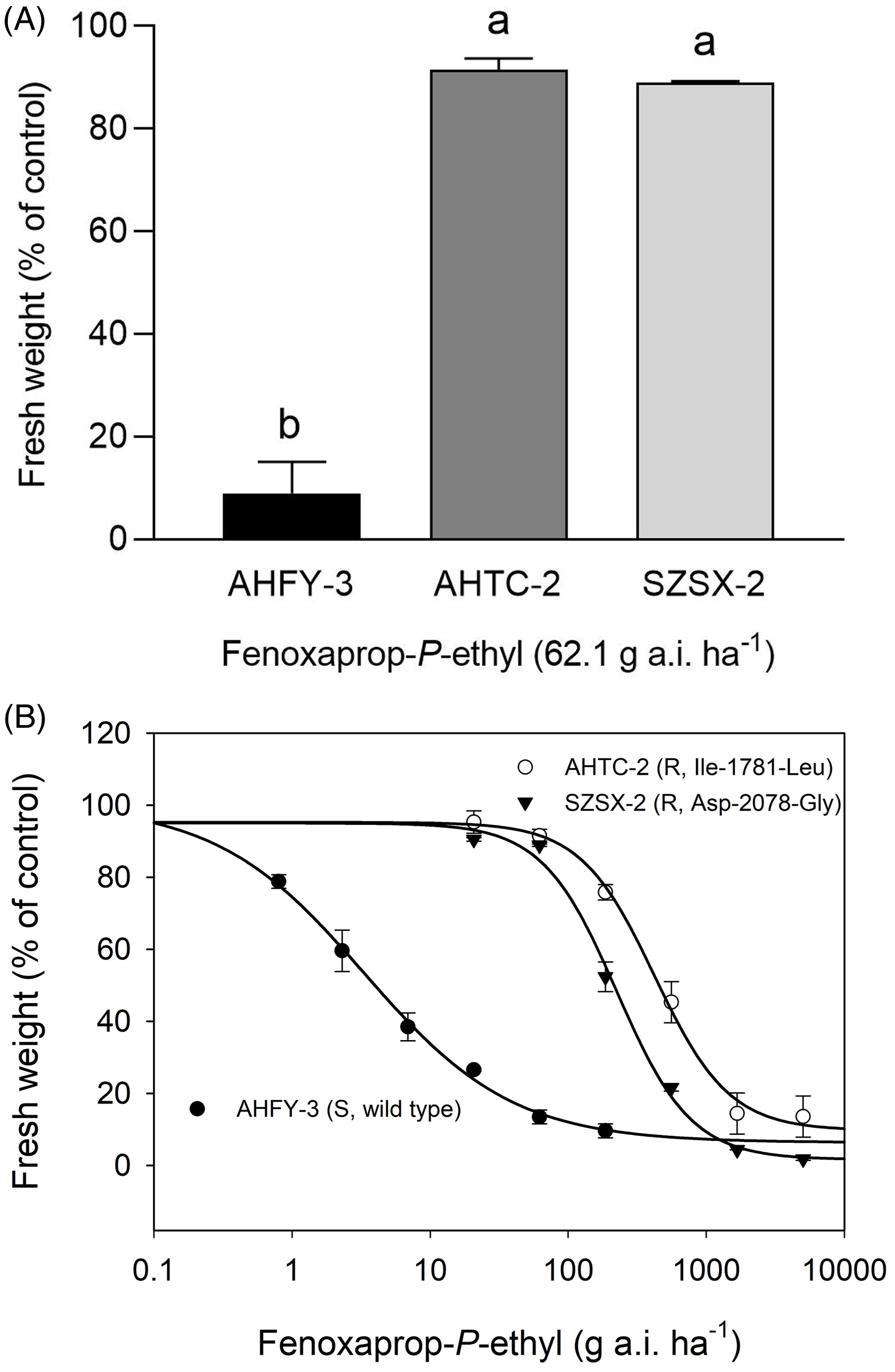
Figure 1. Effects of fenoxaprop-P-ethyl treatments on the growth of the susceptible (S, AHFY-3) and two resistant (R, AHTC-2 and SZSX-2) populations of Alopecurus aequalis. (A) Weed plants from all three populations, at the 3- to 4-leaf stage, received fenoxaprop-P-ethyl at the recommended field rate (62.1 g ai ha−1) or water as an untreated control. Fresh weights for plants under each treatment were assessed 21 d after treatment and expressed as a percentage (%) of the untreated control. Distinct letters denote statistically significant differences at P < 0.05. (B) Dose–response curves of the aboveground biomass (% of control) of the S (AHFY-3) and two R (AHTC-2 and SZSX-2) populations of A. aequalis for a series of application rates of fenoxaprop-P-ethyl. The data for AHFY-3, AHTC-2, and SZSX-2 were fit with four-parameter nonlinear logistic models: y = 6.37 + 93.92/[1 + (x/3.34)]0.81 (R2 = 0.9983), y = 9.72 + 85.54/[1 + (x/415.52)]1.62 (R2 = 0.9961), and y = 1.65 + 93.41/[1 + (x/224.74)]1.62 (R2 = 0.9950), respectively. The curves and data for the S population AHFY-3 were reused with permission from Wang et al. (Reference Wang, Tang, Liao, Cao and Zhao2023), ©2024 John Wiley and Sons. Vertical bars represent the standard errors of the mean.
To assess the resistance levels of the two R populations to fenoxaprop-P-ethyl, whole-plant dose–response experiments were carried out (Figure 1B). The GR50 values of AHTC-2 and SZSX-2 to fenoxaprop-P-ethyl were 415.52 and 224.74 g ai ha−1, respectively, significantly higher than that of AHFY-3 (3.34 g ai ha−1) (Table 1). Based on the RI values, AHTC-2 and SZSX-2 were confirmed to be about 124- and 67-fold more resistant to fenoxaprop-P-ethyl, respectively, characterizing them as highly resistant (RI > 10).
Gene Sequencing of ACCase Revealing Two Common Resistance Mutations
Following PCR, ACCase gene fragments of 1,437-bp length were successfully amplified from different individuals within each population (n = 15). These gene fragments were subsequently aligned with the documented ACCase sequence (GenBank: AJ310767) of black-grass (Alopecurus myosuroides Huds.), revealing a remarkable >99% similarity. Comparison of the ACCase fragments between the S and R samples identified single-nucleotide changes, specifically A-to-T and A-to-G in the ACCase of AHTC-2 and SZSX-2, respectively. These changes led to Ile-to-Leu and Asp-to-Gly substitutions at codons 1781 and 2078 of the ACCase, as illustrated in Figure 2. Furthermore, the frequency of the resistance mutation was found to be 87% and 73% in the ACCase genes of AHTC-2 and SZSX-2 plants, respectively.
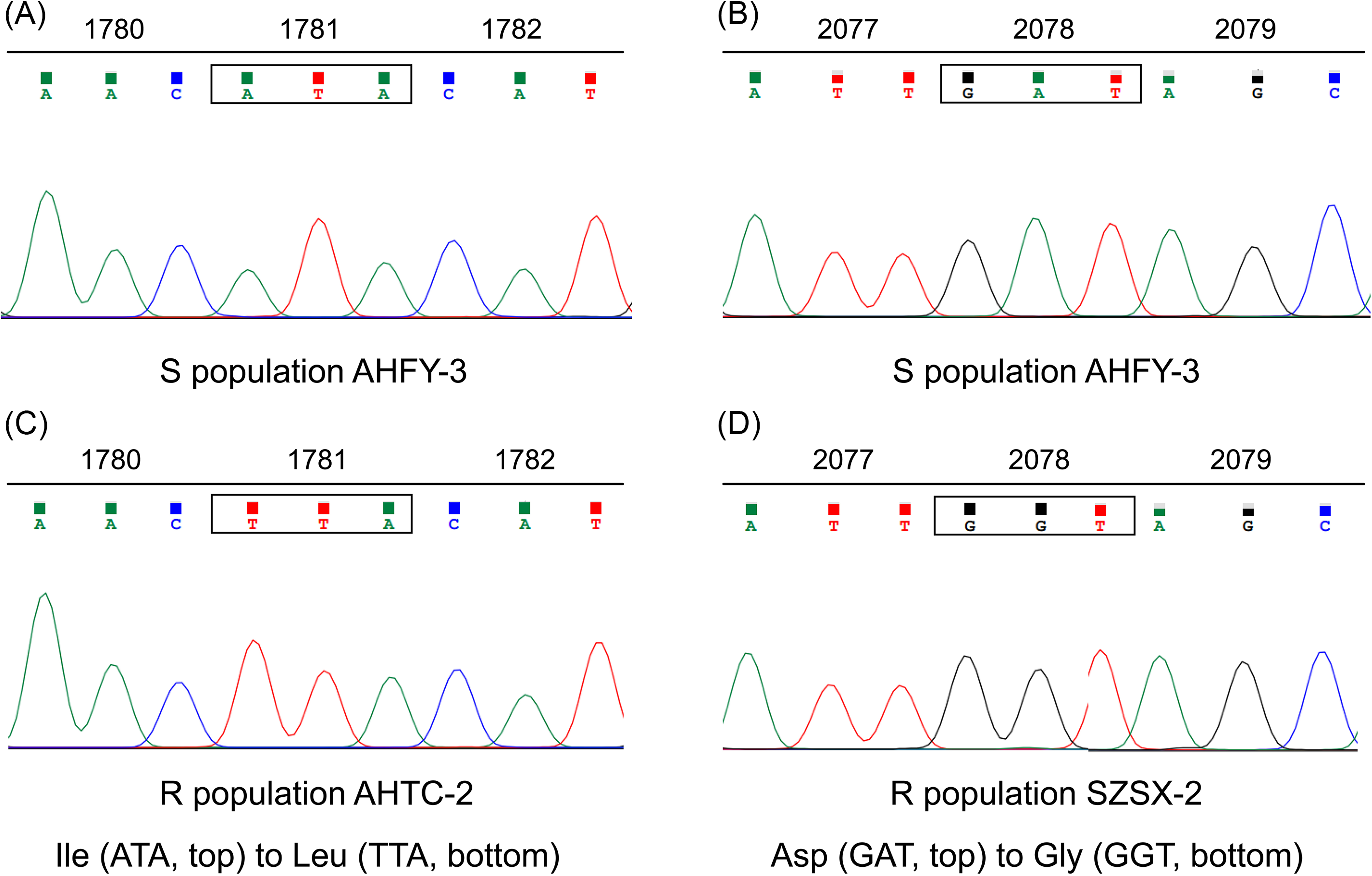
Figure 2. DNA sequencing results showing the wild-type codons (A) Ile-1781 and (B) Asp-2078 in the ACCase genes of the susceptible (S) plants (AHFY-3, top) of Alopecurus aequalis and the mutant codons (C) Ile-1781-Leu and (D) Asp-2078-Gly in those of the resistant (R) plants (AHTC-2 and SZSX-2, bottom). The ACCase codons at positions 1781 and 2078 are highlighted in black boxes.
LAMP Detection of Different ACCase Mutations in Alopecurus aequalis
Previous reports have highlighted the challenge in selecting the optimal set of primers and determining the ideal reaction conditions for LAMP detection, despite the relative ease of primer design (Badolo et al. Reference Badolo, Bando, Traoré, Ko-Ketsu, Guelbeogo, Kanuka, Ranson, Sagnon and Fukumoto2015; Tomita et al. Reference Tomita, Mori, Kanda and Notomi2008). In this study, artificially introduced mismatches were employed to enable the designed primers to specifically and efficiently amplify mutant ACCase sequences from A. aequalis (Table 2; Figure 3). The final optimal LAMP reaction systems for detecting each mutation were also determined and found to be identical (Table 3). Regarding the reaction conditions, LAMP reactions were incubated at 63.0 C for 50 min for Ile-1781-Leu and at 63.5 C for 45 min for Asp-2078-Gly. To aid in visual identification, SYBR Green I was added into the final system, allowing for direct observation with the naked eye.
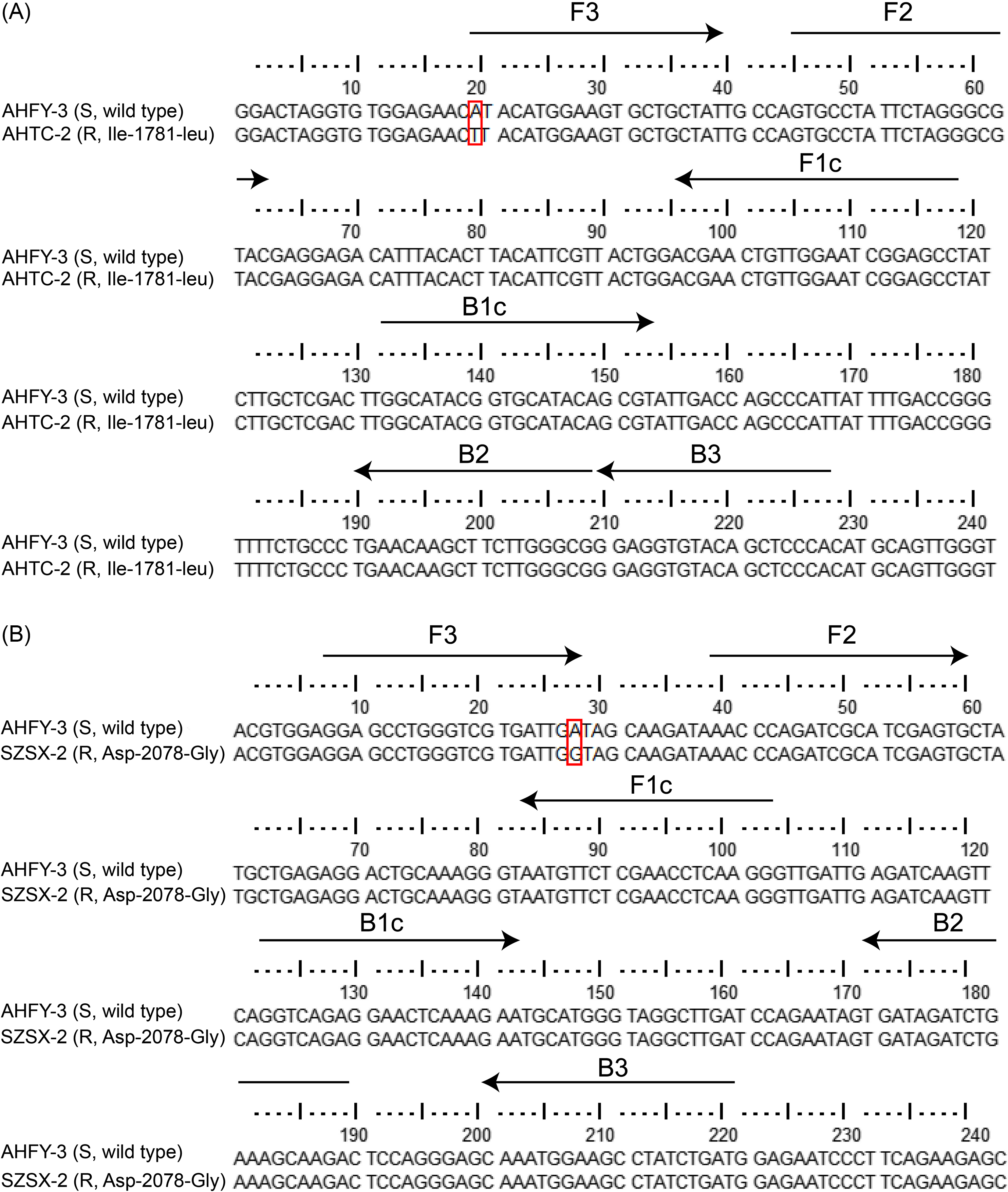
Figure 3. Alignment of partial nucleotide sequences of ACCase from the susceptible (S) AHFY-3 and two resistant (R) populations, (A) AHTC-2 and (B) SZSX-2, of Alopecurus aequalis. The sequences employed as loop-mediated isothermal amplification (LAMP) primers are indicated by arrows, with F3 and B3 serving as the outer primers, and Forward Inner Primer (FIP) comprising F2, the complementary sequence of F1 (F1c), and backward inner primer (BIP) comprising B2 and the complementary sequence of B1 (B1c). The point mutations in the ACCase genes of resistant plants are highlighted in red boxes.
Table 3. Optimized reaction systems for the developed LAMP detections
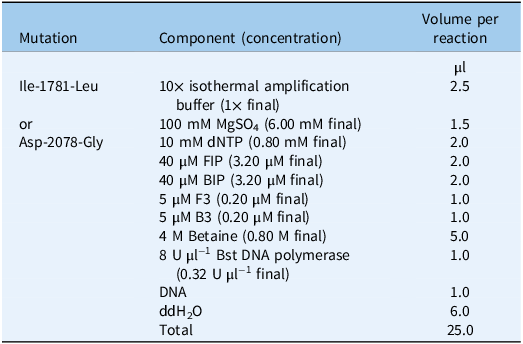
Note: BIP, backward inner primer; FIP, forward inner primer.
DNA extracted from the S and two R populations was employed to evaluate the efficacy of the LAMP primer sets in detecting each specific mutation. The final LAMP products from the DNA samples of the two R populations, AHTC-2 (Ile-1781-Leu) and SZSX-2 (Asp-2078-Gly), displayed ladder-like banding patterns, while that from the DNA of the S population, AHFY-3 (WT), and the negative control (CK) with no templates showed no bands on agarose gels (Figure 4A and 4B). Upon addition of dye, the color of the R systems turned yellow, whereas that of the S system and the negative controls maintained orange red (Figure 4C and 4D). Through optimal LAMP reactions, both primer sets functioned effectively in detecting specific ACCase mutations in A. aequalis.
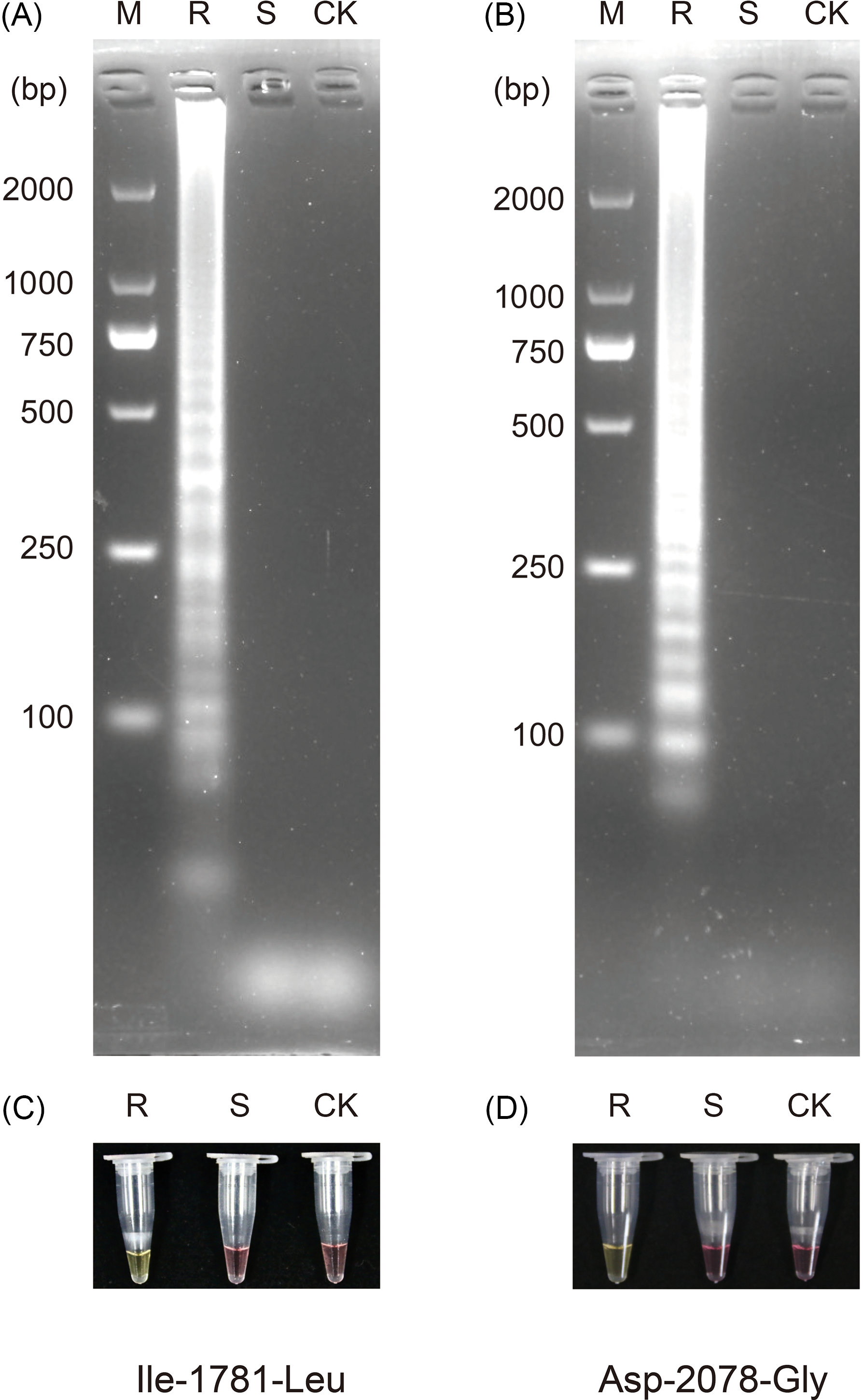
Figure 4. Specificity of loop-mediated isothermal amplification (LAMP) in the detection of the (A, C) Ile-1781-Leu and (B, D) Asp-2078-Gly mutations of ACCase in the fenoxaprop-P-ethyl-resistant Alopecurus aequalis populations AHTC-2 and SZSX-2, respectively. The visualization of LAMP products is achieved through the addition of dye and agarose gel electrophoresis. R, AHTC-2 (A, C) or SZSX-2 (B, D) population; S, AHFY-3 population; CK, double-distilled water; and M, 2k DNA marker.
To date, a total of four distinct ACCase mutations have been identified to confer resistance to ACCase-inhibiting herbicides in the ACCase genes of A. aequalis (Guo et al. Reference Guo, Chi, Feng, Tian, Liu and Wang2018). Employing optimized primers, systems, and conditions, the LAMP assays developed in this study can rapidly distinguish between WT individuals and mutants of A. aequalis harboring Ile-1781-Leu or Asp-2078-Gly in the ACCase enzyme. In conjunction with our previous research, LAMP-based methodologies have been successfully devised for the detection of the three most prevalent mutations, whereas that for identifying the infrequent Ile-2041-Thr mutation in the ACCase of A. aequalis has yet to be developed. In addition, in A. aequalis, six amino acid substitutions at codons 197 and 574 of ALS have been identified to influence the efficacies of ALS inhibitors, including mesosulfuron-methyl, which is commonly used to control grass species such as A. aequalis (Tang et al. Reference Tang, Wang, Wang, Yin, Liao, Cao and Zhao2023). The development of LAMP-based assays targeting these mutations will enhance their rapid identification and enable the precise selection of alternative herbicides for effective resistance management. However, the presence of copy number variation in the ALS gene of A. aequalis may reduce the efficacy and accuracy of detection (Iwakami et al. Reference Iwakami, Shimono, Manabe, Endo, Shibaike, Uchino and Tominaga2017; Panozzo et al. Reference Panozzo, Farinati, Sattin and Scarabel2023). Alternative techniques, such as the Cas12a-based one-pot single-nucleotide polymorphism detection method, may offer a more reliable solution for accurately identifying these known ALS mutations in A. aequalis (Zhang et al. Reference Zhang, Zhang, Lu, Tong, Zhang, Yin and Zhang2023).
Difference in Sensitivity between LAMP and Conventional PCR
Detection limits of the developed LAMP reactions and conventional PCR were determined and compared by employing DNA dilutions of different resistant plants as templates. LAMP products were analyzed through agarose gel electrophoresis and visualized with SYBR Green I, whereas PCR products were exclusively separated on agarose gels. For both the Ile-1781-Leu and Asp-2078-Gly mutations, LAMP successfully amplified products with dilutions as low as 10−6 ng μl−1 (Figure 5). The agarose gels displayed ladder-like patterns (Figure 5A and 5D), and the reaction systems turned yellow upon dye addition (Figure 5B and 5E). In contrast, PCR only amplified products with dilutions as low as 10−2 ng μl−1 for the two mutations (Figure 5C and 5F). The developed LAMP reaction exhibited a sensitivity about 104-fold higher than conventional PCR.
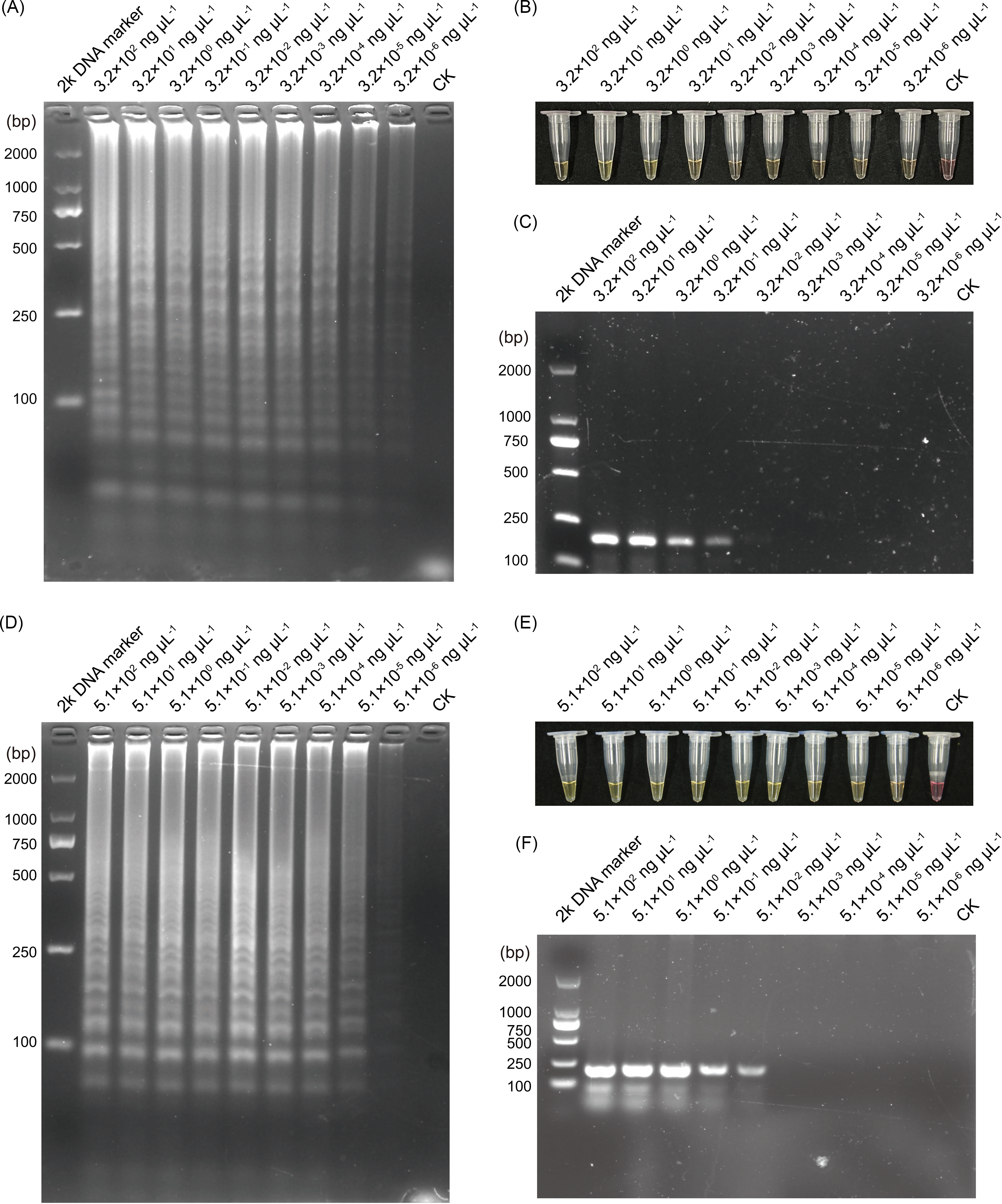
Figure 5. Comparison of the sensitivity between loop-mediated isothermal amplification (LAMP) and conventional polymerase chain reaction (PCR) in the detection of the (A–C) Ile-1781-Leu and (D–F) Asp-2078-Gly mutations of ACCase in Alopecurus aequalis, respectively. (A, D) LAMP assessment through agarose gel electrophoresis. (B, E) LAMP assessment based on color change. (C, F) Conventional PCR assessment via agarose gel electrophoresis. DNA dilutions with concentrations ranging from 102 ng μl−1 to 10−5 ng μl−1, and double-distilled water (CK) were used as templates, respectively.
Genotyping of ACCase Mutant Plants Using dCAPS Markers
Two dCAPS markers were subsequently developed to rapidly identify the Ile-1781-Leu and Asp-2078-Gly mutations in fenoxaprop-P-ethyl–resistant plants of A. aequalis. Regarding Ile-1781-Leu, after ScaI digestion, individuals carrying heterozygous mutant alleles (RS) exhibited both an undigested 185-bp DNA band and two digested bands at 150 bp and 35 bp. Meanwhile, those with only WT alleles (SS) displayed an undigested 185-bp DNA band (Figure 6A). For Asp-2078-Gly, following SpeI digestion, individuals carrying homozygous mutant alleles (RR) exhibited two digested bands at 174 bp and 32 bp. Those with heterozygous mutant alleles (RS) exhibited both an undigested 206-bp DNA band and two digested bands at 174 bp and 32 bp. Finally, those with only WT alleles (SS) presented an undigested 206-bp DNA band (Figure 6B). Both dCAPS markers reliably differentiate between homozygous and heterozygous mutant plants, and the dCAPS analysis results were consistent with the sequencing data for each individual.
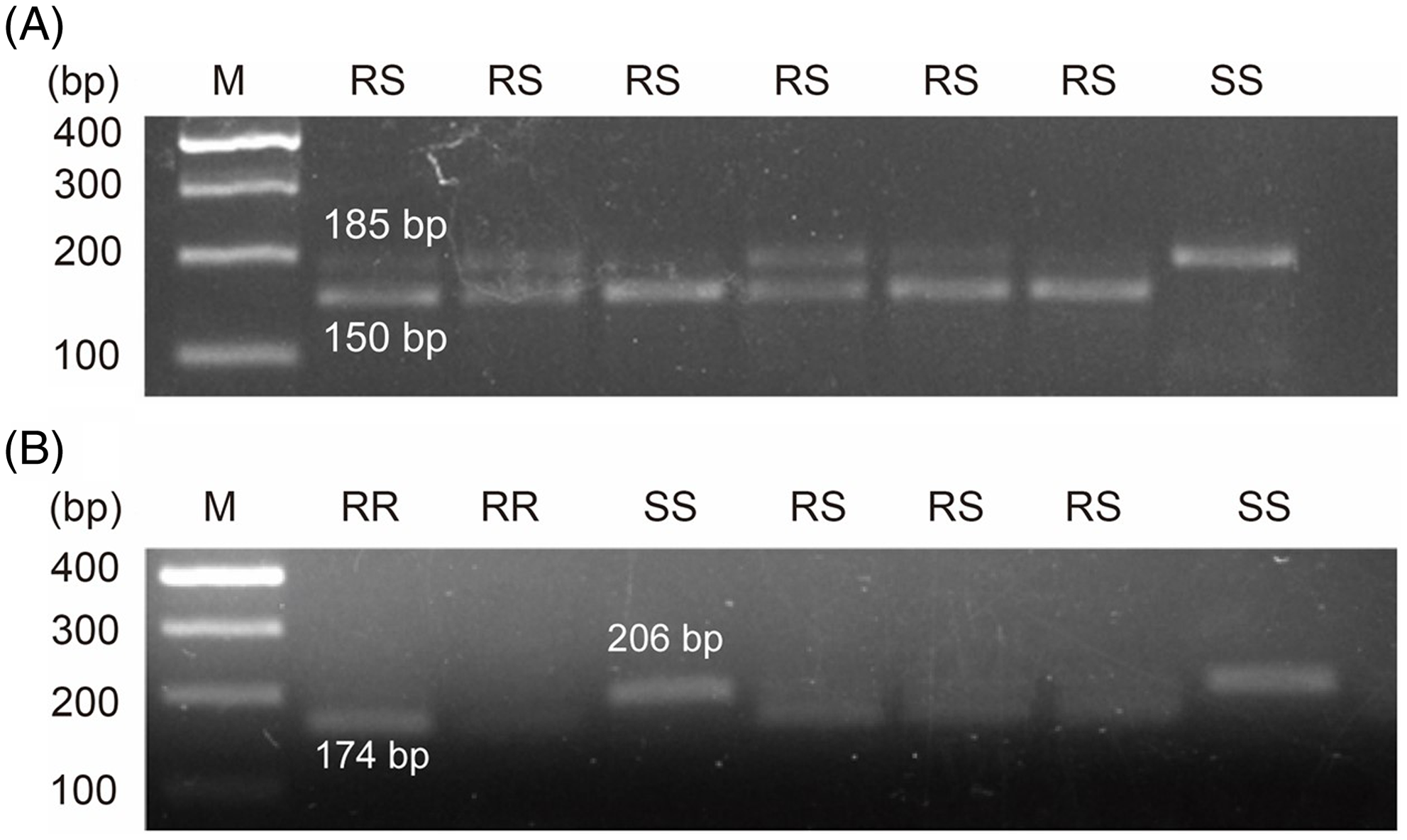
Figure 6. Derived cleaved amplified polymorphic sequence (dCAPS) markers for the detection of (A) Ile-1781-Leu and (B) Asp-2078-Gly mutations in the ACCase genes of Alopecurus aequalis. In (A), the ScaI digestion pattern reveals a single undigested 185-bp band corresponding to susceptible Ile-1781 alleles, while the two digested bands of 150 bp and 35 bp correspond to resistant Ile-1781-Leu alleles (with the 35-bp band invisible on agarose gel). In (B), the SpeI digestion pattern shows a single undigested 206-bp band for susceptible Asp-2078 alleles, and the two digested bands of 174 bp and 32 bp correspond to resistant Asp-2078-Gly alleles (with the 32-bp band invisible on agarose gel). M, 100-bp DNA ladder; RR, homozygous mutant alleles; RS, heterozygous mutant alleles; and SS, susceptible (wild-type) alleles.
In the detection of various ACCase resistance mutations, the established LAMP reactions offer some advantages compared with conventional methods. For instance, PCR detection typically requires much higher DNA concentrations, involves tedious and technical procedures, and utilizes more expensive reagents and equipment. In contrast, the LAMP reaction enables the detection of specific gene mutations in DNA samples at a relatively low concentration and can be conducted using a regular water bath, providing a constant isothermal condition (Notomi et al. Reference Notomi, Okayama, Masubuchi, Yonekawa, Watanabe, Amino and Hase2000). Furthermore, the resulting products are easily visualized through color change, facilitating the rapid recognition of known mutations in target weeds under field conditions. Nevertheless, certain limitations were noted for the LAMP method, especially its inability to distinguish heterozygosity in ACCase mutations. Considering that another simple molecular detection technology, the dCAPS method, can easily distinguish individuals carrying homozygous and heterozygous resistant alleles using agarose gel electrophoresis (Délye et al. Reference Délye, Pernin and Michel2011), a combination of dCAPS and LAMP would be more powerful in determining ACCase mutation type and homozygosity. In this current study, a dCAPS assay was also developed for the detection of each ACCase mutation, and restriction digestion patterns could clearly indicate the mutant status of target codons by counting the number of bands displayed in gels (Figure 6). Similar methods have been established for the detection of different ACCase mutations in ACCase-resistant American sloughgrass [Beckmannia syzigachne (Steud.) Fernald] and demonstrated feasibility (Pan et al. Reference Pan, Li, Xia, Zhang and Dong2015a). Of course, it is anticipated that future advancements in the LAMP assay will facilitate the precise differentiation between homozygous and heterozygous mutation genotypes.
In summary, this study has successfully developed LAMP-based tools for the efficient detection of two common ACCase mutations, namely Ile-1781-Leu and Asp-2078-Gly, which have been found to be associated with high levels of fenoxaprop-P-ethyl resistance in A. aequalis species. Moreover, dCAPS assays have been established for each of these mutations, enabling the differentiation of heterozygosity in resistant plants. These tools hold promise for effectively controlling A. aequalis plants carrying such mutations through the timely adoption of alternative chemical agents.
Acknowledgments
This work was funded by the Major Project of Science and Technology Innovation Platform in Anhui Province (202305a12020007) and the Talent Research Project of Anhui Agricultural University (rc342004).
Competing interests
The authors declare no conflicts of interest.












